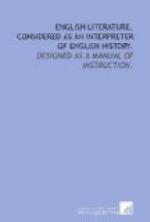MINOR POEMS.—His earliest attempt, doubtless, was the Romaunt of the Rose, an allegorical poem in French, by William de Lorris, continued, after his death in 1260, by Jean de Meun, who figured as a poet in the court of Charles le Bel, of France. This poem, esteemed by the French as the finest of their old romances, was rendered by Chaucer, with considerable alterations and improvements, into octosyllabic verse. The Romaunt portrays the trials which a lover meets and the obstacles he overcomes in pursuit of his mistress, under the allegory of a rose in an inaccessible garden. It has been variously construed—by theologians as the yearning of man for the celestial city; by chemists as the search for the philosopher’s stone; by jurists as that for equity, and by medical men as the attempt to produce a panacea for all human ailments.
Next in order was his Troilus and Creseide, a mediaeval tale, already attempted by Boccaccio in his Filostrate, but borrowed by Chaucer, according to his own account, from Lollius, a mysterious name without an owner. The story is similar to that dramatized by Shakspeare in his tragedy of the same title. This is in decasyllabic verse, arranged in stanzas of seven lines each.
The House of Fame, another of his principal poems, is a curious description—probably his first original effort—of the Temple of Fame, an immense cage, sixty miles long, and its inhabitants the great writers of classic times, and is chiefly valuable as showing the estimation in which the classic writers were held in that day. This is also in octosyllabic verses, and is further remarkable for the opulence of its imagery and its variety of description. The poet is carried in the claws of a great eagle into this house, and sees its distinguished occupants standing upon columns of different kinds of metal, according to their merits. The poem ends with the third book, very abruptly, as Chaucer awakes from his vision.
“The Legend of Good Women” is a record of the loves and misfortunes of celebrated women, and is supposed to have been written to make amends for the author’s other unjust portraitures of female character.
THE CANTERBURY TALES.—In order to give system to our historic inquiries, we shall now present an outline of the Canterbury Tales, in order that we may show—
I. The indications of a general
desire in that period for a reformation
in religion.
II. The social condition of the English people.
III. The important changes in government.
IV. The condition and progress of the English language.




